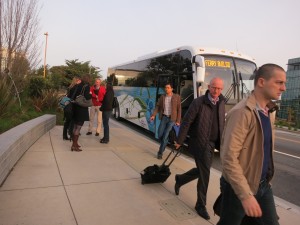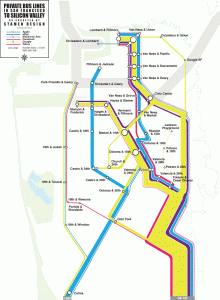By Francesca Segré

When is a bus more than a bus? When it's a luxury coach, complete with deep-tinted windows and sunroof and Wi-Fi and reserved for a sort of exclusive club: employees for high-tech firms in Silicon Valley and the Peninsula south of San Francisco.
A couple months, ago, San Francisco writer Rebecca Solnit wrote a piece for the London Review of Books that pointed to the "Google Bus"—her collective term for all the buses whisking high-tech workers to their company campuses—as one of the most visible symbols of the region's high-tech boom and the troubles it's inflicting on those not lucky enough to participate. Solnit describes the buses alternately as spaceships for "our alien overlords" and as vehicles carrying postmodern coal miners to endless toil in postmodern mines. Here's how she ends the essay:
" ... There are ways in which technology is just another boom and the Bay Area is once again a boomtown, with transient populations, escalating housing costs, mass displacements and the casual erasure of what was here before. I think of it as frontierism, with all the frontier’s attitude and operational style, where people without a lot of attachments come and do things without a lot of concern for their impact, where money moves around pretty casually, and people are ground underfoot equally casually. Sometimes the Google Bus just seems like one face of Janus-headed capitalism; it contains the people too valuable even to use public transport or drive themselves. In the same spaces wander homeless people undeserving of private space, or the minimum comfort and security; right by the Google bus stop on Cesar Chavez Street immigrant men from Latin America stand waiting for employers in the building trade to scoop them up, or to be arrested and deported by the government. Both sides of the divide are bleak, and the middle way is hard to find."
That's a lot of cultural freight for a bus to carry, and my editor didn't say anything about that when we talked about the assignment. Instead, my mission was to try to take my recording equipment and get on one of the buses run by Facebook, Google, Apple and the like, show a slice of life onboard, then give some idea where they fit into the bigger picture of the Bay Area transportation system.
Despite the widespread curiosity about the buses, and last year's cool project by Stamen Designs to document company bus routes and stops, neither Facebook nor Google was interested in having a reporter ride one of their services or even in talking about them. But Genentech, the South San Francisco biotech firm, was happy to have me aboard one of its "gene buses."
Genentech was one of the first companies to build its own fleet of private commuter buses for workers. Since starting the service, which carries people from as far away as Vacaville to the headquarters campus, the company says it has saved 100 million driving miles for employees who no longer have to use their private cars.
